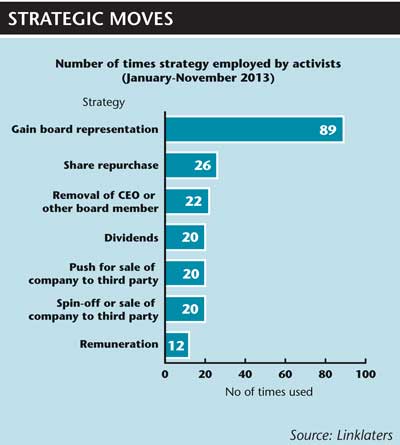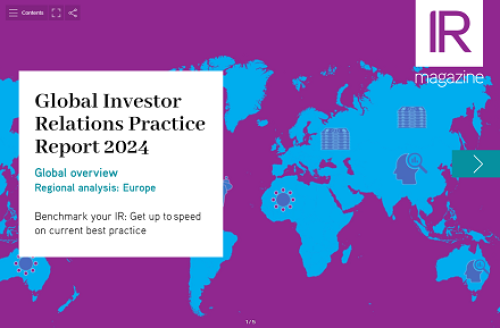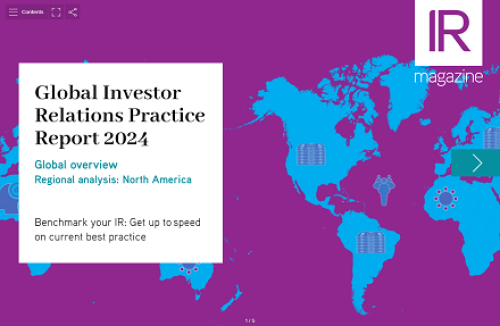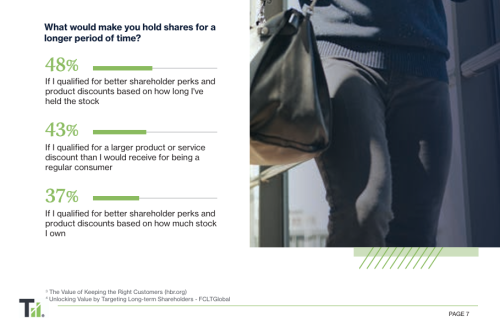What is the best way to engage with the growing and diversifying ranks of activist investors?
Listed firms are now expected to be prepared to deal with activist investors and the challenges they might bring to a firm and its boardroom. According to a recent study produced by Linklaters, the international law firm, the number of shareholder actions carried out across the globe swelled by 88 percent between January 1, 2010 and September 30, 2013, with the majority of that growth taking place in Europe and the US.
SEC chairman Mary Jo White described the influx as ‘a good thing’ for companies at the 10th annual Transatlantic Corporate Governance Dialogue organized by the European Corporate Governance Institute in December 2013.
‘I think most would agree the advice on how to respond to shareholder engagement today is quite different from the advice companies were getting 30 years ago, or even 10 years ago,’ she said. ‘The process has become less defensive and more proactive. We are seeing a concerted effort to persuade shareholders of the wisdom of management’s choices and practices.’ Reaching out to activists, then, could form an increasingly important part of an IR professional’s role.
Diverse interests
The Linklaters study reveals that the number of shareholders with a stated activist strategy has more than doubled within the last decade, while activism is now spread across a more diversified range of sectors than ever before, including services and technology (see How activist targets have changed below). 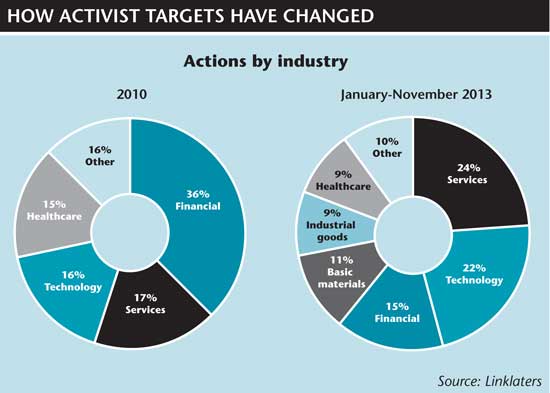
David Drake, president of proxy solicitation firm Georgeson, says shareholder activists are most often to be found in business sectors or industries that have recently underperformed.
‘There tends to be a rotation of industries based on relative valuation of companies in that industry,’ he explains. ‘If you find an industry where there are a significant number of underperforming companies or companies that are trading at lower multiples than the market as a whole, and investors see opportunities to close that gap, those industries could represent the next haven for activist input.
Drake, a frequent speaker and writer on proxy fights and investor activism, has spent more than 20 years working in shareholder-facing roles. Prior to joining Georgeson in 1997, he served as a senior analyst and director of US research at ISS, and remains a member of several trade bodies. Targets for activism are not determined by industry alone, he notes.
‘I do tend to look at things a little differently,’ he points out. ‘I usually look at prime targets for activism around different themes that make companies attractive to activist funds or investors.’
In most cases, Drake says, these will be companies with an excess of cash, though firms that are – or appear to be – conglomerates with multiple lines of business are also prime targets. ‘The platform for the dissident investor would perhaps be for the spin-off of a particular part of the business that might add value, or restructuring that may produce at least a short-term benefit, if not a long-term one,’ he explains.
Market motivation
The spread of activism received a boost from the market conditions that followed the financial crisis of 2008, according to Andrew Shapiro, president of Lawndale Capital Management.
‘Most underwater investors were seeking any and all catalysts to return and unlock value in depressed stock prices,’ he recalls. ‘While 2008 was our worst market-to-market year ever, it was our most successful year in both the number and scope of changes we were able to bring about in our portfolio. Following this market meltdown, further exchange and regulatory rule changes – Dodd-Frank, for example – and plain old public scrutiny of failed corporate governance brought about enhanced board sensitivity to active shareowner demands.
‘The lengthy period of low interest rates and quantitative easing that followed meant US companies’ balance sheets could be rebuilt, paving the way for a wave of buyout activity. This activity stems from – and creates – ownership activism as well.’
As a founder of Lawndale, Shapiro has overseen the management of several activist hedge funds focused on small and micro-cap companies for more than 20 years. Though it was once a fringe approach to investing, activists’ strategies have widely matured, with more emphasis on research, collaboration and a long-term view attracting more backers.
In the 2013 proxy season, for example, several institutional investors maintained regular lines of communication with activists, while some even shared potential ‘hit lists’ of potential targets, according to Martin Lipton of law firm Wachtell Lipton Rosen & Katz in a Harvard Law School blog. In the post, Lipton argues that activist hedge funds have become an asset class in their own right.
The amount of money flowing into activist funds was also highlighted at a 2013 IR Magazine Think Tank in New York. ‘Over the last two years, activist assets have grown about 23 percent, to more than $500 bn, including inflows and market performance,’ said one attendee (who must remain anonymous as IR Magazine Think Tanks operate under the Chatham House rule). ‘Hedge fund assets within that group have grown about 35 percent and now represent 61 percent of the total, up from 55 percent.’
Shapiro, however, doesn’t believe activist funds should be labelled as an asset class. ‘They’re more a form of ownership in certain companies with certain attributes,’ he explains.
Getting together
One of the key benefits of being able to engage directly with activists, says Matt Rhodes, head of investor relations at US software company Intuit, is that of getting another point of view. Rhodes recounts a ‘very positive’ experience at Intuit when the company was dealing with the Californian activist fund Relational Investors. Set up in 1996 by Ralph Whitworth, Relational now manages more than $6 bn of assets in mostly large-cap companies. One of Relational’s other founders, David Batchelder, has served as a director at Intuit since 2009.
‘Relational had a clear point of view on how we could be managing and communicating about the business differently, and it conveyed its thoughts in a constructive way,’ Rhodes explains. ‘Its team was engaged, and David was a respected and effective board member.’
Being shown to engage with a respected outside opinion, Rhodes adds, can certainly help your cause. ‘From an IR perspective, working well with an activist demonstrates that your company is not operating in isolation and is open-minded and willing to consider all ideas to maximize growth and profitability,’ he reveals. ‘If investor relations provides appropriate transparency about how it engages with activists or other investors with strong points of view, the firm comes across as rational and credible. Shareholders want to be heard; we should listen.’
Activists are, by definition, people who have chosen to make their belief in a company concrete through investment, and they may well have the firm’s best interests close to heart, notes Shapiro. ‘Boards rarely have any real shareholders as directors and, when they do, they are very often not professional investors but people who own the shares as founders, or through inheritance or thanks to a compensation grant,’ he says. ‘Activists have real skin in the game and it’s likely their investment is a sizable part of a concentrated portfolio. As a result, the activist is going to be potentially more highly focused on the company, its industry and business than a legacy director will.’
Another benefit activist investors bring, Shapiro adds, is providing to both management and IROs a ‘fresh, educated perspective direct from the investment community…. They will likely know where stock is held or which managers will most likely be a fit for the company’s stock. Educated feedback on roadshow presentations and themes also becomes available to the IR department.’
For Drake, rather than reaping the benefits of activist engagement, it is more a case of avoiding the risks of failing to engage that can make the difference to how your company is perceived. ‘There are benefits to engaging – you may learn something actionable, certainly – but the converse is that avoiding engagement is very risky in terms of how a proxy contest may play out,’ he notes.
‘Part of the process, too, is risk management, in that if you stiff-arm the activist investor and don’t engage, that works against you in a number of ways. For example, when activists approach a company they’re generally also approaching other investors. Your top shareholders will therefore be hearing the activists’ thesis on what’s wrong with the company or what could be improved or changed.’
Public perceptions
Problems arise, Drake continues, if it becomes apparent that you have been less than generous to activists with your time, or with senior management’s time.
‘If the activist is able to publicly say that management or the board has actively avoided engaging with him or her, that could look really bad,’ he concludes. ‘It also works against you if you’re embroiled in a proxy fight and you need to talk to one of the advisory firms, like ISS.
‘One of [ISS’] analysts – in meeting with your board or management when deciding which side to support – may ask, To what extent have you engaged with activists? How far did you go to see whether there were areas you agreed on? If you haven’t gone down that road or engaged with the investors, you don’t have good answers to those questions.’
‘The most important thing, in my opinion, when an activist emerges is to avoid the natural knee-jerk reaction, or to go into the bunker and close off all dialogue,’ warns Shapiro. ‘Escalation and hostility is inherently distracting and costly to all parties. For these reasons, IROs ought to work to keep lines of communication open between senior management, the board and the activist.’
Rhodes echoes this sentiment. ‘As long as we’re communicating clearly and honestly about our company’s health and prospects, everything will take care of itself,’ he says. He warns that the nature of a technology-rich economy – where it is easier for some companies to fall behind their peers or new entrants – has created the perception that new ideas create shareholder value, and that activists will bring those new ideas.
A generation of particularly outspoken activists might also be attracted to the rewards and high profile that investors such as Carl Icahn have successfully gained. ‘A new generation of outspoken activists is attracted to the spoils, namely media attention and money,’ Rhodes continues. ‘These activists have seen investors like Icahn succeed with that model in the past and now they’re emulating it.’
Over the past year in particular, Icahn has gained a great deal of attention through his online approach to activism. At first using his Twitter account to announce a new position in Apple, he later mounted a campaign to convince the company to deploy a large amount of its cash reserves in a $150 bn share buyback program.
Icahn has since launched a new discussion platform for activists called the Shareholders’ Square Table, offering them the opportunity to unite and fight for improved investor rights and aiming for ‘the goal of real corporate democracy’.
Social work
Social media is a tricky platform for activist engagement. According to FTI Consulting Group’s recent digital engagement study, although 80 percent of institutional investors expect shareholder activists to increase their use of social media to influence companies, only 11 percent are confident that publicly traded companies can defend themselves by using the same medium.
Such statistics led Elizabeth Saunders, FTI’s senior managing director, to declare social media as ‘a new battleground’ from which activists would attack corporate America. ‘This is a wake-up call to companies that investor relations and corporate communications teams can no longer operate as independent silos – particularly in the case of social media, through which information and opinions are so rapidly generated,’ she comments in the study.
Shapiro, meanwhile, urges IR teams and their companies to make sure they retain a long-term approach at the center of what they do. ‘There are some solutions pushed by activists that contribute to the labeling of short-termism at the expense of long-term sustainable value,’ he says. ‘The issue is then to determine who the activist is and what his or her historical agenda is.’
In order to combat such investors, Rhodes suggests the investor relations department works closely with legal and communication teams to consider how actions and announcements could be amplified by an activist with a personal agenda.
‘Activists tend to get involved when company performance is falling short of competitors’ performance or Street expectations, so focusing on improving the business is the best – though not always the easiest – way to respond,’ he says. ‘If IR can demonstrate that management and the board are thoughtfully considering investors’ ideas, that can go a long way toward mitigating media noise.’
Passive problems
Thinking of the potential dangers that might arise in proxy season, Drake notes that larger-cap firms could attract their own difficulties, given the number of shares held by passively managed funds.
‘Invariably, many of these [large-cap] companies now have passive investors or index funds as their largest investors,’ he notes. ‘As you’re analyzing your shareholder base, and how shareholders behave, you might see that larger blocs of proxy votes could come from passively managed funds and the like. It’s important IROs be aware of these investors and have a strategy for engaging with them. In the case of index funds, generally you’re dealing with someone who’s a corporate governance specialist rather than an industry expert or analyst, and they can get ignored by activist outreach and other schemes. It’s important to remember to engage with them, too.’
In essence, then, managing the advances of activists – especially those who gain a seat in a company’s boardroom – is consistent with the rest of the investor relations role, and requires a strong and consistent approach to communication. For many, too, it remains a case of maintaining both a strong sense of a firm’s identity while being open to the potential for beneficial change that many activists pride themselves on.